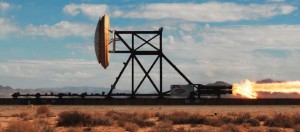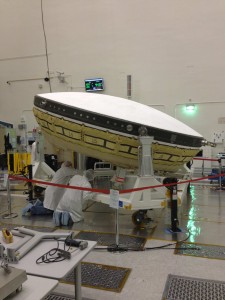
A rocket sled test series has been led by JPL and conducted at the U.S. Naval Air Weapons Station at China Lake. Credit: NASA/JPL

NASA workers at the agency’s Jet Propulsion Laboratory, wearing clean room “bunny suits,” prepare the Low Density Supersonic Decelerator (LDSD) technology test article for shipment later this month to Hawaii. Credit: NASA/JPL
If larger and larger payloads – including human habitats – are to set down safely on Mars, new atmospheric reentry technologies are required.
NASA’s Jet Propulsion Laboratory (JPL) is deep into cutting-edge and crosscutting demonstration flights of hardware to land hefty payloads on the Red Planet.
The work is being done under NASA’s Low Density Supersonic Decelerator (LDSD) technology demonstration project.
Last week some of the LDSD work was showcased at JPL. That hardware is headed for a first flight into near-space this June, launched from the U.S. Navy’s Pacific Missile Range Facility on Kauai, Hawaii.
In addition to the testing in Hawaii, a rocket sled test series has been led by JPL and conducted at the U.S. Naval Air Weapons Station at China Lake.
Saucer-shaped
The LDSD equipment has taken on the looks of a rocket-powered, saucer-shaped test vehicle.
These new drag devices are one of the first steps on the technology path to potentially landing humans, habitats, and their return rockets safely on Mars.
Furthermore, LDSD work will also allow access to much more of the planet’s surface by enabling landings at higher-altitude sites.
NASA’s Space Technology Mission Directorate is developing to create the new knowledge and capabilities necessary to enable our future missions to an asteroid, Mars and beyond. The directorate is committed to developing the critical technologies required to enable future exploration missions beyond low Earth orbit.
Take a look at this video on NASA’s LDSD efforts, at:
https://www.youtube.com/watch?v=9h1NtQJ59kM
By Leonard David
